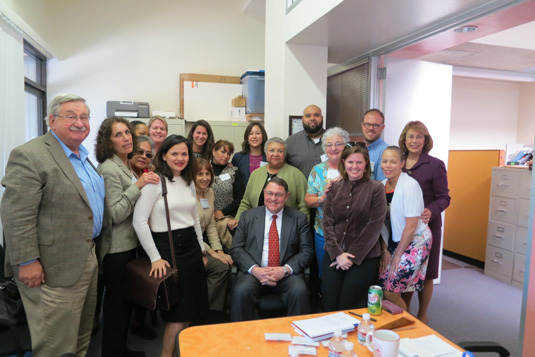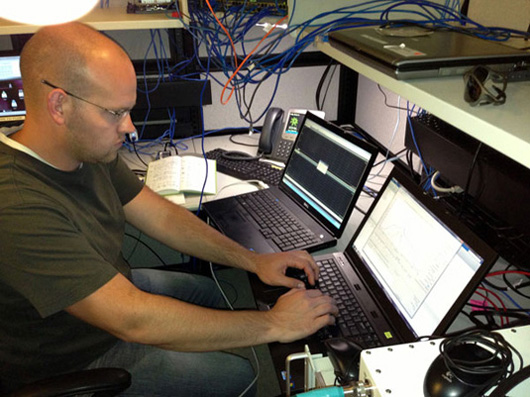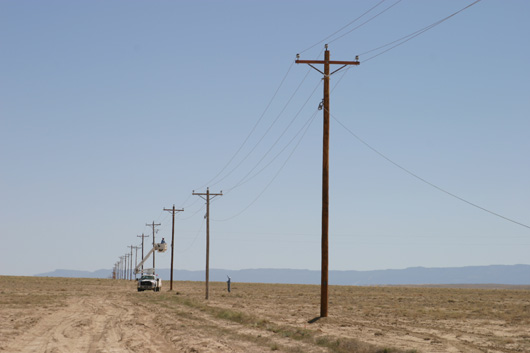NTIA Blog
NTIA Working With States on FirstNet Planning
As part of our efforts to help ensure the success of the nation’s first nationwide public safety broadband network, NTIA this week hosted the first of two workshops to help states and territories provide input and prepare for the launch of the First Responder Network Authority’s (FirstNet) network.
This week’s workshop, held in Atlanta for Eastern states, allowed attendees to meet with FirstNet officials on the progress of state consultation and planning for the public safety network. A second workshop is scheduled for March 11-12 in Phoenix for Western states.
NTIA launched the State and Local Implementation Grant Program (SLIGP) last summer to provide grants to states and territories to support planning, consultation and outreach activities in preparation for the launch of the FirstNet network. NTIA awarded more than $116 million in grants to assist states and territories in planning for the FirstNet network.
In addition to providing a forum for state and territory officials to interact with FirstNet staff, the workshops allow states to discuss how planning is going, to learn from each other on stakeholder outreach and governance structures, and to develop regional connections and collaboration. At the same time, NTIA officials provide grant recipients with information on how to ensure they comply with conditions of their grant awards.
Working to Close the Digital Divide in Silicon Valley
Silicon Valley has long been a hub of technological innovation and promise in our country. It’s the birthplace of iconic technology companies such as Intel, Apple, Cisco, and Google. And regions across the country – and even around the world – attempt to emulate its success.
This week, I joined Commerce Secretary Penny Pritzker and other Commerce Department leaders in travelling to Silicon Valley to promote the Department’s initiatives to spur U.S. economic growth, innovation, and competitiveness.
We’re meeting with leaders of technology powerhouses, fledgling start-ups, and venture capitalists funding the next big idea. Yet, we recognize that not everyone in the region has shared in the wealth created in Silicon Valley. Yesterday I had the privilege of meeting with a number of groups including the California Emerging Technology Fund (CETF), the Chicana/Latina Foundation, the Latino Community Foundation, and others that are working tirelessly across the state to close the digital divide.

Leaders from Silicon Valley-area community groups gather with Assistant Secretary Strickling to talk about bridging the digital divide.
Spotlight on NTIA: Lee Dixon, office manager, Office of Chief Counsel
This post is part of our “Spotlight on NTIA” blog series, which is highlighting the work that NTIA employees are doing to advance NTIA’s mission of promoting broadband adoption, finding spectrum to meet the growing demand for wireless technologies, and ensuring the Internet remains an engine for innovation and economic growth.
 Lee Dixon hasn’t had a career. He’s had many careers: Air Force entertainer, jet mechanic, military recruiter, personnel technician, piano lounge singer, security guard, ordained Baptist minister, and most recently office manager for NTIA’s Office of Chief Counsel.
Lee Dixon hasn’t had a career. He’s had many careers: Air Force entertainer, jet mechanic, military recruiter, personnel technician, piano lounge singer, security guard, ordained Baptist minister, and most recently office manager for NTIA’s Office of Chief Counsel.
But perhaps the one role he can’t seem to get away from is singer. One of his first professional moments in the spotlight came in the Air Force, when he spent two years as a member of the Air Force’s highly acclaimed entertainment troupe known as “Tops in Blue.” He traveled the world to entertain Air Force members stationed abroad. In the years since then, he has sung at weddings and other events and even had a two-month stint accompanying a piano player at a club in Florida.
NTIA Applauds DoD’s Spectrum Strategy Efforts
The U.S. Defense Department (DoD) took an important step forward today in support of the Administration’s plans to make additional spectrum available for wireless broadband, issuing a spectrum strategy document. We applaud DoD’s efforts and look forward to continued collaboration with DoD and other federal agencies as we explore new and innovative approaches to meet the exploding demand for spectrum.
Through its Electromagnetic Spectrum Strategy, DoD recognizes that meeting the military’s mission requirements amidst the growing commercial and consumer demand will require cooperation, compatibility, and flexibility. Indeed, a key focus of its plan is to develop spectrum-dependent systems that are efficient, flexible, and adaptable in their use of the spectrum.
Recognizing the important role spectrum plays in continued innovation, job creation, and economic growth, the Administration is moving aggressively to enhance spectrum efficiency and enable access to more spectrum for consumer services and applications. The long-term spectrum needs for government agencies and industry alike will be met primarily through sharing, and NTIA is asking for a top-to-bottom commitment from all stakeholders to make it happen.
Working to Provide a Better National Broadband Map
Since its launch in 2011, the National Broadband Map, a joint project of NTIA and the Federal Communications Commission (FCC), has been providing key data on where broadband is available throughout the country and who is providing it. Today, we’re rolling out the seventh edition of the map. In addition to providing updated data, the latest version of the broadband map includes some enhancements such as a more detailed summary page for each state as well as additional information about broadband providers and their subsidiaries.
The latest data, from June 30, 2013, shows the country continues to make steady progress in expanding access to broadband. Most Americans have access to wired broadband (93 percent), while 98 percent have access to wireless broadband at the most basic broadband speed, defined at 3 Megabits per second (Mbps) downstream and 768 kilobits per second (kbps) up. The data also show that 99 percent of the U.S. population has access to this basic broadband through either a wired or wireless service. Here are other highlights from the latest data:
Digital Learning Program Prepares Students for School, Careers and Life in the 21st Century
Today is Digital Learning Day, a nationwide celebration of the innovative use of technology in education to improve learning and prepare students to succeed in college and careers in the 21st century.
The Obama administration recognizes the critical importance of digital learning to our nation’s future. Just yesterday, the White House announced over $750 million in private-sector commitments to supply free software, devices, home wireless connectivity and professional development support for teachers. These pledges bring us an important step closer to achieving the President’s ConnectED goal to get ultra-fast Internet connections and educational technology into K-12 classrooms nationwide.
NTIA to Convene First Facial Recognition Technology Multistakeholder Meeting
This week, the Commerce Department is taking an important step in our campaign to drive innovation and better protect consumer privacy in the digital economy. On Thursday, the agency’s National Telecommunications and Information Administration (NTIA) will bring together representatives from technology companies, trade groups, consumer groups, academic institutions and other organizations to kick off an effort to craft privacy safeguards for the commercial use of facial recognition technology.
This initiative is the second “multistakeholder process” launched by NTIA to implement the Obama Administration’s consumer data privacy framework. The centerpiece of that framework is the Consumer Privacy Bill of Rights, which lays out high-level principles for protecting consumer privacy in today’s networked world. The multistakeholder processes will establish voluntary, enforceable codes of conduct to apply the Bill of Rights in specific business contexts.
Commerce Promotes Digital Economy at State of the Net
(The following originally appeared on Commerce.gov)
Over the past 20 years, the Internet has radically transformed the way Americans work and play. And it continues to be a key driver of innovation, job creation and overall economic expansion.
At the Commerce Department, we understand the importance of the Internet to America’s digital economy and the continued growth of the global economy. That’s why preserving a vibrant, open and free-flowing Internet is a core mission of our agency.
Today, Commerce Secretary Penny Pritzker addressed the 10th annual State of the Net conference, where she shared the Department’s commitment to promoting policies that support America’s digital economy. And she pledged to act as the champion of good Internet policy that supports entrepreneurs, businesses, and their workers.
Exploring Spectrum Sharing Through Technical Studies
Recognizing the importance of making additional spectrum available for wireless broadband to drive innovation, expand consumer services, and promote continued economic growth, NTIA is working hard to explore new options for federal government and industry to share spectrum. The Obama Administration is committed to making available an additional 500 MHz of spectrum for commercial use this decade, and spectrum sharing will be a critical component of that effort.

NTIA/ITS engineer John Carroll using a computer-controlled measurement system to gather data on radar-to-LTE interference effects. Photo by Frank Sanders.
Narrowing the Digital Divide in the Navajo Nation
Spread across the Four Corners region of the American Southwest, the Navajo Nation is home to up to 175,000 members of the Navajo Tribe. Tribal members live scattered across more than 27,000 square miles of land stretching from northeast Arizona to northwest New Mexico to southeast Utah.
It’s a place where many roads have never been paved, many buildings don’t have a formal postal address and thousands of families remain cut off from the electrical grid. At least 60 percent of homes don’t have landline telephone service even though wireless signals are often spotty or nonexistent. The 911 system often cannot track where people are calling from during an emergency. And high-speed Internet access has been almost entirely unavailable.

Data from the National Broadband Map, which is maintained by NTIA in collaboration with the Federal Communications Commission, show that less than 4 percent of the population living in Navajo Nation territory has access to even the most basic wireline broadband speeds of 3 megabits per second downstream.
But with a $32 million grant from NTIA’s Broadband Technology Opportunities Program (BTOP), the Navajo Tribal Utility Authority is bringing a modern wireless communications system to a region that has been all too frequently bypassed by amenities that most Americans take for granted.
